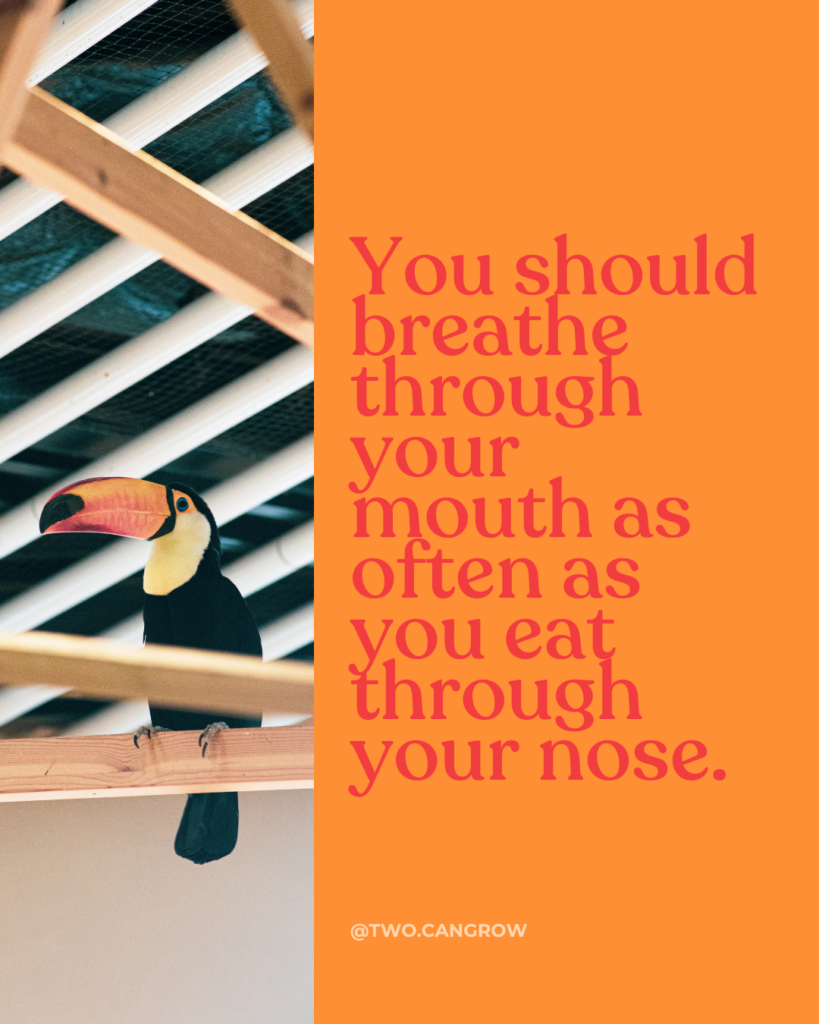
We often find ourselves marveling at every aspect of a new baby. Their hands, tiny toes, cheeks, and lips. Almost everything. And I remember a time when I would look at photos of babies sleeping with their mouths wide open thinking to myself, aw, how cute.
When my sister had her first and experienced significant feeding and sleep challenges I begun digging and researching in an attempt to find answers to their problems. Part of that discovery led me to mouth breathing and the realization that it was the complete opposite of cute…Now as a Speech Language Pathologist, Feeding Therapist, and Sleep Specialist, I cannot unsee mouth breathing, and when I do, alarm bells start ringing.
Mouth breathing is so common that it has become normalized in our society. And the truth is most people don’t realize is that mouth breathing can have significant, negative, long-term implications on our health and well-being.

Optimal Oral Rest Posture aka Nasal Breathing
We don’t consciously think about our rest posture but I want you to take a moment and tune into your mouth. Where is your tongue resting? Are your lips sealed or apart? Are you clenching at all?
Our bodies are designed for nasal breathing. In fact, we are born obligate nasal breathers. This means, when we are awake (when not talking or eating) and while asleep, we should breathe…
- with our lips sealed
- teeth slightly apart or not touching
- tongue suctioned/resting on the roof of the mouth (and I mean the whole tongue, not just the tip!), and
- breathing through our noses
Nasal Breathing VS Mouth Breathing
While many may perceive mouth breathing as a natural part of a baby’s development, it’s crucial to recognize the difference between mouth breathing and the preferred nasal breathing.
Nasal Breathing
- Supports air filtration. The air you breathe in is warm and acts as a filter, preventing bacteria and allergens, preventing them from entering the respiratory system.
- Helps release nitric oxide, which increases oxygen uptake in the lungs and better oxygen circulation to the rest of your body
- Improves oxygenation as nasal breathing allows for slower, more controlled breathing, optimizing oxygen and carbon dioxide exchange in the lungs. This can enhance overall respiratory efficiency.
- Releases endorphins and calms the nervous system. Nasal breathing is associated with the activation of the parasympathetic nervous system, which helps keep us regulated, relaxed, and reduces stress.
- Supports healthy oral-facial development by promoting proper tongue posture, jaw alignment, and optimal muscle function. This contributes to the development of a well-formed and balanced facial structure.
- Aids in getting healthy, restful sleep by optimizing airway patency, filtering and humidifying inhaled air, and promoting improved oxygenation, contributing to deep REM sleep, better overall sleep quality and respiratory function.
Mouth Breathing
- Bypasses filtration: Mouth breathing bypasses the nasal passages, leading to reduced filtration and humidification of air. The air you breathe is cold, and unfiltered, allowing more allergens and pollutants to enter the respiratory system. Over time it can lead to inflammation of the tonsils, adenoids, and gum tissue, making you more susceptible to developing illnesses and infections
- Reduces Nitric Oxide, which may compromise the ability to fend off pathogens, potentially increasing the susceptibility to respiratory infections. It can also contribute to long-term cardiovascular issues, including increased blood pressure and decreased overall cardiovascular function.
- Can cause dryness in the mouth and throat, increasing the risk of dental issues such as bad breath, tooth decay
- Alters facial development as it leads to improper tongue posture, dental malocclusion, high and narrow palate, and facial asymmetry
- Can contribute to sleep disruptions including impaired REM sleep, grinding, snoring, frequent waking, restlessness, dark eye circles during the day, sleep disordered breathing, and sleep apnea.
- May contribute to anxiety by disrupting the balance of oxygen and carbon dioxide in the bloodstream, leading to increased sympathetic nervous system activity and a heightened stress response.
Signs and Symptoms of Mouth Breathing
While parted lips are a common sign of mouth breathing, there are other indicators that can suggest a child may be a mouth breather. These signs may include:
- Dry, cracked lips
- Dry Mouth
- Drooling and/or drool stains on bed sheets
- Bad Breath (Halitosis)
- Gum issues such as gingivitis
- Dental malocclusion such as open bite, underbite, cross bite, or crowded teeth
- Noisy breathing
- Enlarged Tonsils and Adenoids
- Noisy Breathing
- Snoring
- Frequent respiratory infections
- Altered facial development
- Chronic Fatigue
- Dark circles under the eyes
Causes of Mouth Breathing
- Allergies
- Chronic nasal congestion
- Tongue tie
- Low tongue posture
- Oral habits such as prolonged pacifier use, thumb or finger sucking
- Enlarged adenoids and/or tonsils
- Enlarged nasal turbinates and/or deviated septum
4 Tips to Avoid Mouth Breathing
- Create a Nasal-Friendly Environment: Ensure a healthy indoor environment by using air purifiers and humidifiers. This helps minimize irritants that could contribute to nasal congestion, making it easier for your child to breathe through their nose.
- Clear the Nasal Passageways: For infants, saline rinses can help clear their nasal passages. This can make it more comfortable for them to breathe through their nose.
- Encourage the lips to seal, with the tongue suctioned to the roof of the mouth from day 1. The sleeping tongue posture hold is a great exercises to help support nasal breathing and optimal rest posture.
- Address/Rule out underlying red flags: Consult with a speech-language pathologist or occupational therapist to complete a functional, oral motor feeding evaluation. If you’re in Northern VA, contact me today!